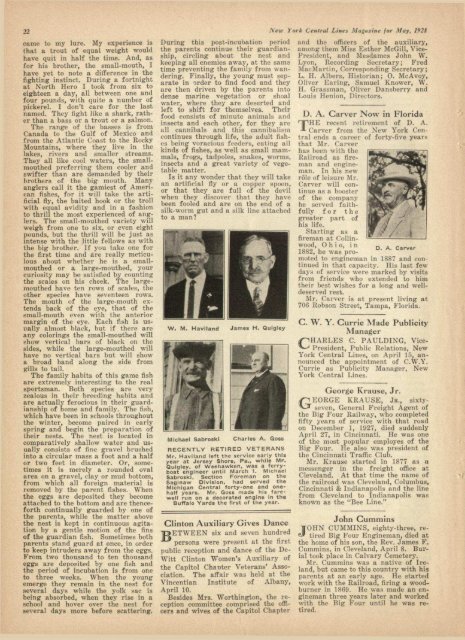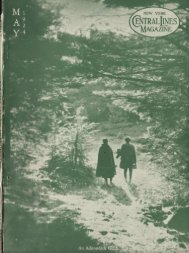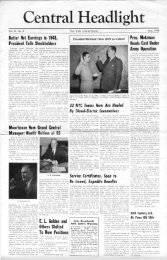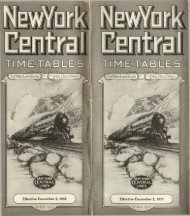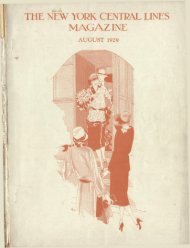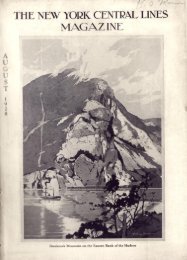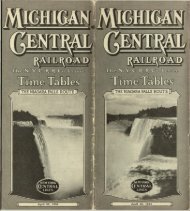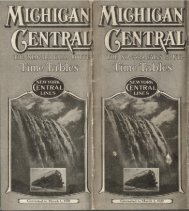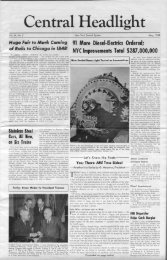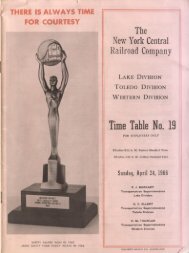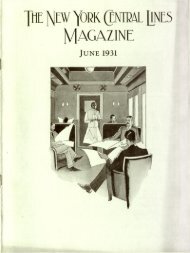Create successful ePaper yourself
Turn your PDF publications into a flip-book with our unique Google optimized e-Paper software.
12<br />
came to my lure. My experience is<br />
that a trout of equal weight would<br />
have quit in half the time. And, as<br />
for his brother, the small-mouth, I<br />
have yet to note a difference in the<br />
fighting instinct. During a fortnight<br />
at North Hero I took from six to<br />
eighteen a day, all between one and<br />
four pounds, with quite a number of<br />
pickerel. I don't care for the last<br />
named. They fight like a shark, rather<br />
than a bass or a trout or a salmon.<br />
The range of the basses is from<br />
<strong>Canada</strong> to the Gulf of Mexico and<br />
from the Atlantic Coast to the Rocky<br />
Mountains, where they live in the<br />
lakes, rivers and smaller streams.<br />
They all like cool waters, the smallmouthed<br />
preferring them cooler and<br />
swifter than are demanded by their<br />
brothers of the big mouth. Many<br />
anglers call it the gamiest of American<br />
fishes, for it will take the artificial<br />
fly, the baited hook or the troll<br />
with equal avidity and in a fashion<br />
to thrill the most experienced of anglers.<br />
The small-mouthed variety will<br />
weigh from one to six, or even eight<br />
pounds, but the thrill will be just as<br />
intense with the little fellows as with<br />
the big brother. If you take one for<br />
the first time and are really meticulous<br />
about whether he is a smallmouthed<br />
or a large-mouthed, your<br />
curiosity may be satisfied by counting<br />
the scales on his cheek. The largemouthed<br />
have ten rows of scales, the<br />
other species have seventeen rows.<br />
The mouth of the large-mouth extends<br />
back of the eye, that of the<br />
small-mouth even with the anterior<br />
margin of the eye. Each fish is usually<br />
almost black, but if there are<br />
any colorings the small-mouthed will<br />
show vertical bars of black on the<br />
sides, while the large-mouthed will<br />
have no vertical bars but will show<br />
a broad band along the side from<br />
gills to tail.<br />
The family habits of this game fish<br />
are extremely interesting to the real<br />
sportsman. Both species are very<br />
zealous in their breeding habits and<br />
are actually ferocious in their guardianship<br />
of home and family. The fish,<br />
which have been in schools throughout<br />
the winter, become paired in early<br />
spring and begin the preparation of<br />
their nests. The nest is located in<br />
comparatively shallow water and usually<br />
consists of fine gravel brushed<br />
into a circular mass a foot and a half<br />
or two feet in diameter. Or, sometimes<br />
it is merely a rounded oval<br />
area on a gravel, clay or mud bottom,<br />
from which all foreign material is<br />
removed by the parent fishes. When<br />
the eggs are deposited they become<br />
attached to the bottom and are thenceforth<br />
continually guarded by one of<br />
the parents, while the matter above<br />
the nest is kept in continuous agitation<br />
by a gentle motion of the fins<br />
of the guardian fish. Sometimes both<br />
parents stand guard at once, in order<br />
to keep intruders away from the eggs.<br />
From two thousand to ten thousand<br />
eggs are deposited by one fish and<br />
the period of incubation is from one<br />
to three weeks. When the young<br />
emerge they remain in the nest for<br />
several days while the yolk sac is<br />
being absorbed, when they rise in a<br />
school and hover over the nest for<br />
several days more before scattering.<br />
During this post-incubation period<br />
the parents continue their guardianship,<br />
circling about the nest and<br />
keeping all enemies away, at the same<br />
time preventing the family from wandering.<br />
Finally, the young must separate<br />
in order to find food and they<br />
are then driven by the parents into<br />
dense marine vegetation or shoal<br />
water, where they are deserted and<br />
left to shift for themselves. Their<br />
food consists of minute animals and<br />
insects and each other, for they are<br />
all cannibals and this cannibalism<br />
continues through life, the adult fishes<br />
being voracious feeders, eating all<br />
kinds of fishes, as well as small mammals,<br />
frogs, tadpoles, snakes, worms,<br />
insects and a great variety of vegetable<br />
matter.<br />
Is it any wonder that they will take<br />
an artificial fly or a copper spoon,<br />
or that they are full of the devil<br />
when they discover that they have<br />
been fooled and are on the end of a<br />
silk-worm gut and a silk line attached<br />
to a man?<br />
W. M. Havlland James H. Quigley<br />
Michael Sabroski Charles A. Goss<br />
RECENTLY RETIRED VETERANS<br />
Mr. Haviland left the service early this<br />
year at Jersey Shore, Pa., while Mr.<br />
Quigley, of Weehawken, was a ferryboat<br />
engineer until March 1. Michael<br />
Sabroski, Section Foreman on the<br />
Saginaw Division, had served the<br />
Michigan Central forty-one and onehalf<br />
years. Mr. Goss made his farewell<br />
run on a decorated engine in the<br />
Buffalo Yards the first of the year.<br />
Clinton Auxiliary Gives Dance<br />
"in»ETWEEN six and seven hundred<br />
persons were present at the first<br />
public reception and dance of the De-<br />
Witt Clinton Women's Auxiliary of<br />
the Capitol Chanter Veterans' Association.<br />
The affair was held at the<br />
Vincentian Institute of Albany,<br />
April 10.<br />
Besides Mrs. Worthington, the reception<br />
committee comprised the officers<br />
and wives of the Capitol Chapter<br />
New York Central Lines Muguzine fur .May, 192S<br />
and the officers of the auxiliary,<br />
among them Miss Esther McGill, Vice-<br />
President, and Mesdames John W.<br />
Lyon, Recording Secretary; Fred<br />
MacMartin, Corresponding Secretary;<br />
L. H. Albers, Historian; O. McAvoy,<br />
Oliver Earing, Samuel Knower, W.<br />
H. Grassman, Oliver Dansberry and<br />
Louis Henion, Directors.<br />
D. A. Carver Now in Florida<br />
HE recent retirement of D. A.<br />
TCarver from the New York Central<br />
ends a career of forty-five years<br />
that Mr. Carver<br />
has been with the<br />
Railroad as fireman<br />
and engineman.<br />
In his new<br />
role of leisure Mr.<br />
Carver will continue<br />
as a booster<br />
of the company<br />
he served faithfully<br />
for the<br />
greater part of<br />
his life.<br />
Starting as a<br />
fireman at Collinwood,<br />
Ohio, in<br />
1882, he was pro D. A. Carver<br />
moted to engineman in 1887 and con<br />
tinued in that capacity. His last few<br />
days of service were marked by visits<br />
from friends who extended to him<br />
their best wishes for a long and welldeserved<br />
rest.<br />
Mr. Carver is at present living at<br />
706 Robson Street, Tampa, Florida.<br />
C. W. Y. Currie Made Publicity<br />
Manager<br />
HARLES C. PAULDING, Vice-<br />
C President, Public Relations, New<br />
York Central Lines, on April 15, announced<br />
the appointment of C.W.Y.<br />
Currie as Publicity Manager, New<br />
York Central Lines.<br />
George Krause, Jr.<br />
EORGE KRAUSE, Jr., sixty-<br />
G seven, General Freight Agent of<br />
the Big Four <strong>Railway</strong>, who completed<br />
fifty years of service with that road<br />
on December 1, 1927, died suddenly<br />
April 27, in Cincinnati. He was one<br />
of the most popular employes of the<br />
Big Four. He also was president of<br />
the Cincinnati Traffic Club.<br />
Mr. Krause started in 1877 as a<br />
messenger in the freight office at<br />
Cleveland. At that time the name of<br />
the railroad was Cleveland, Columbus,<br />
Cincinnati & Indianapolis and the line<br />
from Cleveland to Indianapolis was<br />
known as the "Bee Line."<br />
John Cummins<br />
OHN CUMMINS, eighty-three, re<br />
J tired Big Four Engineman, died at<br />
the home of his son, the Rev. James F.<br />
Cummins, in Cleveland, April 8. Burial<br />
took place in Calvary Cemetery.<br />
Mr. Cummins was a native of Ireland,<br />
but came to this country with his<br />
parents at an early age. He started<br />
work with the Railroad, firing a woodburner<br />
in 1869. He was made an engineman<br />
three years later and worked<br />
with the Big Four until he was retired.<br />
New York Central Lines Magazine for May, 1928 23<br />
West Albany employes from the Motive Power, Car and Stores Departments at a Safety meeting at the Railroad Y. M.<br />
C. A., where they pledged themselves to renewed efforts on behalf of fewer casualties.<br />
West Albany Employes Strive<br />
to Improve Safety Record<br />
Ti/irOTIVE Power, Car and Stores<br />
IvJL Department employes and officials<br />
attended a special Safety meeting<br />
at West Albany Shops April 16,<br />
which was addressed by Charles E.<br />
Hill, General Safety Agent.<br />
Mr. Hill, who also attended all of<br />
the Division and principal shop Safety<br />
meetings on the Line East during<br />
April, showed the West Albany men in<br />
chart form their Safety performances<br />
during the years of 1926 and 1927.<br />
The Motive Power Department in<br />
1926 had 151 employe casualties, and<br />
in 1927, 107. The Car Department<br />
reduced its casualties from 30 to 17.<br />
In 1926 the Stores Department had<br />
23 employe casualties, which were cut<br />
to 14 in 1927.<br />
Further reductions in employe casualties<br />
were also made at this point<br />
during January and February, 1928,<br />
under the corresponding months of<br />
1927. The names of some of those<br />
attending this meeting, in the front<br />
row of the picture, from left to right,<br />
are as follows:<br />
F. P. McGirr, Shops Safety Agent;<br />
C. M. Thomas, Safety Agent, Mohawk<br />
Division; George Fox, Superintendent<br />
of Shops, Car Department; John Parsons,<br />
SuDerintendent of Shops, Motive<br />
Power Department; Charles E. Hill,<br />
General Safety Agent; John T. Grow,<br />
District Master Car Builder; E. C.<br />
Totten, General Car Foreman, Weehawken,<br />
and John Seim, District<br />
Storekeeper. In the back row are C.<br />
W. Adams, Division General Car<br />
Foreman, and C. D. Shaff, Supervising<br />
Safety Agent.<br />
S i x R o a d s i n Safety B a l l y at Y o i a e g s t o w e<br />
^CONSIDERABLE impetus was<br />
given to Safety work among employes<br />
by the Co-operative Railroad<br />
Safety Rally held in Youngstown,<br />
Ohio, April 10. Nearly four thousand<br />
employes from six railroads entering<br />
the city crowded the Stambaugh Auditorium<br />
to hear addresses and music.<br />
Dr. J. W. LeSeur, Special Representative<br />
of President P. E. Crowley of<br />
the New York Central Lines, was the<br />
principal speaker.<br />
Dr. LeSeur urged railroad employes<br />
to inculcate Safety in the hearts of<br />
everyone they met, whether at work<br />
or at home. He pointed out that<br />
wealth is not the greatest human attainment,<br />
but rather, service to humanity.<br />
" 'It is more blessed to give<br />
than to receive'," he reminded his<br />
hearers, "and it is service that makes<br />
genuine friendship. Is life worth living?<br />
That all depends on you."<br />
Dr. LeSeur praised the co-operation<br />
given the railroads by city officials in<br />
helping to reduce deaths and accidents<br />
at railroads crossings and at stations.<br />
The greatest reduction in fatalities, he<br />
said, is due to instruction in proper<br />
Safety methods.<br />
The surgeon's address was preceded<br />
by an introduction by Judge George<br />
H. Gessner, who afterward expressed<br />
the audience's appreciation for the<br />
surgeon's visit and invited him to come<br />
again. F. H. Babcock was chairman<br />
of the program.<br />
A motion picture, "The Fair of the<br />
Iron Horse," was shown and several<br />
musical numbers were given by local<br />
talent.<br />
The railroads participating in the<br />
rally were the Baltimore & Ohio, Erie<br />
Railroad, Pennsylvania, Lake Erie &<br />
Eastern, Pittsburgh & Lake Erie and<br />
the New York Central.<br />
Neil Mooney Heads Agents'<br />
Association in East<br />
EIL MOONEY, Assistant Gen<br />
N eral Passenger Agent for the<br />
New York Central in New York, has<br />
been elected President of the General<br />
Eastern Passenger<br />
tion.<br />
Agents' Associa<br />
Upon his induction into office last<br />
month, he was warmly praised by Edgar<br />
S. Barney, retiring president, who<br />
is General Passenger Agent of the<br />
Hudson River Day Line. Addressing<br />
Mr. Mooney, Mr. Barney said:<br />
"You have been honored by election<br />
to the highest office within the gift of<br />
this Association. It is an enviable<br />
office to hold, and richly do you deserve<br />
it. Your fine manhood, your<br />
sterling character, your uniform courtesy,<br />
your winsome smile, your magnanimous<br />
trait of which you, yourself,<br />
have so often told me—of striving to<br />
perform some kindly deed toward<br />
someone every day—all make you the<br />
man whom we delight to honor and<br />
follow. . . .<br />
"I place in your hand this gavel as<br />
a symbol of authority to rule, and I<br />
ask you similarly to transfer it to<br />
your successor. I know you will<br />
wield it in justice. I ask you to wield<br />
it in mercy."


